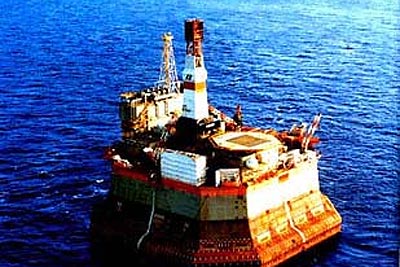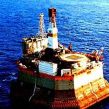
SAKHALIN ENERGY PROJECTS FACE REALITY CHECK
Publication: Eurasia Daily Monitor Volume: 2 Issue: 145
By:

As the Shell-led Sakhalin-2 liquefied natural gas (LNG) project in the Russian Far East faces cost overruns and delays, now Russian Sakhalin ventures appear to be facing a reality check, cooling Moscow’s ambitious plans to tap lucrative energy markets in the Asia-Pacific.
Earlier this month, Sakhalin region governor Ivan Malakhov met Mitsui executives, headed by CEO Shoei Utsuda, to discuss the Sakhalin-2 project. The Mitsui “delegation came to the island to inspect the project first hand, including construction of pipelines from the north to the south of the island, and one of the world’s largest LNG plants,” according to the Sakhalin regional administration (RIA-Novosti, July 18).
Although the official statement was short on specific details, there was a major reason for concerns relative to the Sakhalin-2: the project’s cost estimates have doubled to $20 billion. One of Russia’s major offshore projects, it has reserves of some 150 million tons of oil and 500 billion cubic meters of gas. Oil production at Sakhalin-2 started in 1999.
Royal Dutch/Shell has raised cost estimates for Sakhalin-2 and postponed the first LNG shipment from the end of 2007 to summer 2008. Shell CEO Jeroen van der Veer has conceded an “absolutely staggering” $10 billion cost overrun on Sakhalin-2.
Russian officials, including the Ministry of Industry and Energy, Rosenergo, and the Ministry of Finance, are yet to comment on Shell’s raised cost estimates for Sakhalin-2 (RIA-Novosti, July 15). However, Russian officials are understood to be wary of significant delays in planned LNG exports.
Moreover, Russia’s gas giant Gazprom has agreed to swap a 50% stake in its Siberian Zapolyarnoye gas field for a 25% stake in Sakhalin-2. But earlier this month, Gazprom indicated that it now considered Royal Dutch/Shell’s assets on Sakhalin to be worth less after Shell raised the project’s cost estimates.
Nonetheless, a contract signed by Sakhalin Energy and the Korea Gas Corporation (Kogas), marks the first long-term energy supply arrangements between Russia and South Korea. Under the deal, Sakhalin Energy will ship 1.5 million tons of LNG annually to Kogas for 20 years from a LNG plant south of Sakhalin Island. Construction of the plant is more than half complete, and the facility has a designed annual LNG capacity of 9.6 million tons.
The deal will help Kogas diversify its energy supply and turn the Sakhalin Island into a new strategic source of natural gas for South Korea. Acting Kogas chief Lee Kyu-Sun said the location of Sakhalin and the competitive and flexible supply deal makes Sakhalin LNG “a natural choice” for Kogas. “The partnership with Kogas, the world’s largest buyer of liquefied natural gas, is extremely important to us,” Ian Craig, Sakhalin Energy CEO, declared. Craig also argued that Sakhalin Island could become a long-term strategic supplier of energy to the Korean market (RIA-Novosti, July 15).
However, not everyone was convinced by Sakhalin Energy’s optimistic pronouncements. The European Bank for Reconstruction and Development (EBRD) has decided to delay a loan to the Sakhalin-2 energy project amid environmental concerns over pipeline plans (RIA-Novosti, June 21). Sakhalin Energy announced in March that pipelines would bypass at-risk zones, but now environmentalists claim that the new pipeline routes could damage sturgeon-spawning areas.
In the meantime, the partners in the Sakhalin-1 oil and gas project are considering natural gas supplies to China, according to Rosneft CEO Sergei Bogdanchikov (RIA-Novosti, July 1).
The consortium is hoping to sell natural gas to Japan by constructing a pipeline stretching 2,400 kilometers from Sakhalin to the greater Tokyo area. The pipeline would pump 6 million tons of LNG a year, or about 10% of Japan’s annual consumption. The plan has been in limbo due to lack of progress in negotiations with Japanese gas and power companies, therefore ExxonMobil is now understood to be considering selling the natural gas to China.
The Sakhalin-1 estimated reserves are 2.3 billion barrels (307 million tons) of oil and 485 billion cubic meters of natural gas. But commercial production in the Sakhalin-1 project has trailed that of Sakhalin-2. Last month, when ExxonMobil executives traveled to Sakhalin to meet Governor Ivan Malakhov, the corporation’s president, Rex Tillerson, said oil and gas production would start at Sakalin-1 in September 2005 (RIA-Novosti, June 27). Furthermore, India’s ONGC Videsh Ltd., which has a 20% stake in Sakalin-1, has also complained of cost overruns there.
However, Russia is now trying to lure China’s leading petroleum companies to Sakhalin. Rosneft and Sinopec, a subsidiary of the China National Petroleum Corporation, recently clinched a deal to launch a joint company for geological exploration of the Veninsky deposit, part of the Sakhalin-3 project (RIA-Novosti, July 1).
In January 2004, the Russian government annulled the results of Sakhalin-3 tender, which had been won by a consortium led by ExxonMobil back in 1993. Now state-owned Rosneft holds a 75% stake in Sakhalin-3.
Russia’s Sakhalin projects have been seen as a cornerstone of Moscow’s ambitious plans to expand into Asia-Pacific energy markets. Russia intends to deliver LNG from Sakhalin via Mexico, President Vladimir Putin told visiting Mexican President Vicente Fox last month. “LNG from Sakhalin will be delivered to the Mexican coast and partially used in your country,” Putin said (RIA-Novosti, June 21).
Meanwhile, as major Sakhalin projects appear to face significant cost overruns and delays, it remains to be seen whether their performance could eventually justify Moscow’s confidence in Sakhalin’s future as a dominant hydrocarbon producer in North-East Asia.




